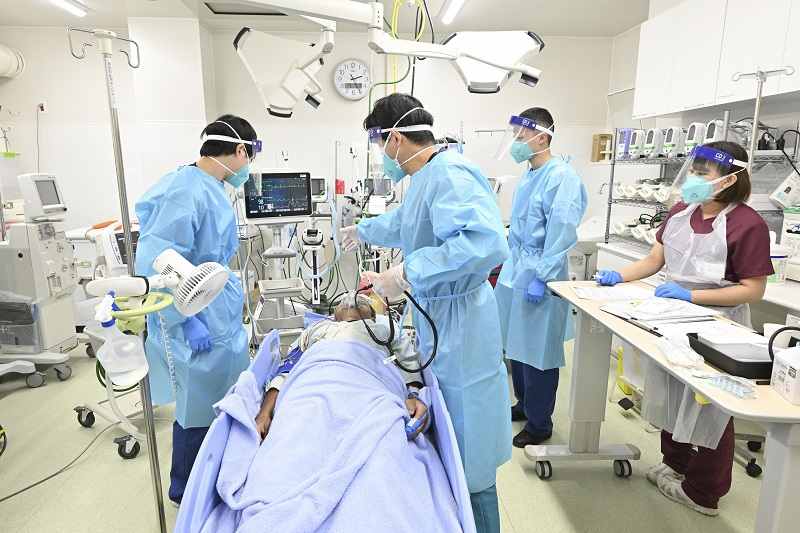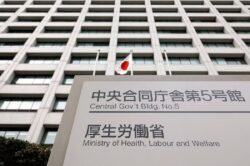
Health care workers treat a patient at the Fujimino Emergency Hospital in Miyoshi, Saitama Prefecture.
20:01 JST, July 22, 2022
The seventh wave of coronavirus infections, marked by record numbers of cases, is putting increasing strain on the health care system. Hospitals in some parts of the country are having to decline coronavirus-related emergency transfers due to a lack of dedicated beds. Affected municipalities are striving to ease the pressure on their medical institutions by increasing bed numbers and limiting hospitalization to patients with moderate or severe symptoms.
80% of transfers rejected
“At the moment, we’ve no choice but to limit hospital admissions because our capacity can’t keep pace with the explosive increase in [coronavirus] infections,” said Akira Kano, director of the Fujimino Emergency Hospital in Miyoshi, Saitama Prefecture.
The hospital has 35 dedicated beds for moderately ill coronavirus patients and, as of the time of writing, had only 20 inpatients. However, Kano said it is difficult to accept new admissions, as the hospital’s Fever Outpatient Department — which sees 1,500 potential COVID-19 patients every day — requires a large number of medical staff, meaning the hospital cannot assign more staff to beds set aside for coronavirus patients.
The hospital, which puts priority on home-based patients with rapidly deteriorating conditions, now has to reject about 80% of emergency transfer requests. In order to make more beds available, it has asked other medical institutions — including so-called aftercare support hospitals that care for post-treatment COVID-19 patients — to accept transfers, but some requests have been turned down. “Unless the situation is addressed quickly, we won’t be able to save lives that potentially could have been saved,” Kano, 49, said.
The Saitama prefectural government is asking medical institutions to increase beds for coronavirus patients by 60% to 1,508 by Monday — 940 beds were in use as of Wednesday. The prefectural government plans to encourage medical institutions to transfer their patients to 166 aftercare support hospitals in the prefecture. “We’re also thinking about designating more medical institutions as aftercare support hospitals,” a prefectural government official said.
Highest alert levels
The Tokyo metropolitan government set its four-tier alert level for medical care provision to the maximum at a monitoring meeting on Thursday. Tokyo already had raised its alert level for coronavirus infections, and, on the day, the two levels reached their highest points since March 17.
Many people cannot take tests or see a doctor on weekends as many outpatient clinics are closed, prompting the monitoring meeting to offer to pay ¥4,300 per patient in “cooperation money” to medical institutions that examine patients on Saturdays and Sundays. It was also decided to establish an accommodation facility with a total of 130 beds in Tachikawa, Tokyo, for people with mild or no symptoms who live with others who have a high risk of developing severe symptoms. “The metropolitan government will promote measures such as strengthening the medical care provision system,” Tokyo Gov. Yuriko Koike said.
Rapid rise
Some municipalities limit hospital admissions in order to avoid a scenario in which severely ill coronavirus patients cannot be accepted.
The Aichi prefectural government on Tuesday notified medical institutions that hospital admission criteria should, in principle, be applied to only allow patients whose condition was at least as severe as “Moderate II,” meaning that they require oxygen. This followed the prefecture’s increase in the number of its dedicated beds for coronavirus patients from 1,214 to 1,723 on July 15.
According to the Cabinet Secretariat, as of Wednesday, the prefecture’s hospital bed occupancy ratio had tripled from two weeks ago to 30%. “If the number of infections continues to rise, inpatient numbers won’t decrease,” Aichi Gov. Hideaki Omura said. “We’re facing a tough situation, but we have to protect the medical care system.”
The Osaka prefectural government reviewed its rules on July 15 to allow only patients with breathing difficulties, pneumonia or worse symptoms to be admitted to hospitals, in principle. Previously, patients with mild symptoms thought to be likely to develop moderate symptoms have also been hospitalized. “We’ll provide medical treatment to people in need in an appropriate manner,” Osaka Gov. Hirofumi Yoshimura said.
The Osaka prefectural government asked medical institutions Thursday to secure 700 additional “emergency evacuation” beds for COVID patients. “We’re working flat-out to avoid a shortage of hospital beds,” an Osaka prefectural government official in charge of the matter said.
"Society" POPULAR ARTICLE
-

M4.9 Earthquake Hits Tokyo, Neighboring Prefectures
-

M7.5 Earthquake Hits Northern Japan; Tsunami Waves Observed in Hokkaido, Aomori and Iwate Prefectures
-

Tsukiji Market Urges Tourists to Avoid Visiting in Year-End
-

Israeli Tourists Refused Accommodation at Hotel in Japan’s Nagano Pref., Prompting Protest by Israeli Embassy and Probe by Prefecture
-

Beloved Cat Stationmaster Nitama in Wakayama Pref. Passes Away at 15
JN ACCESS RANKING
-

Keidanren Chairman Yoshinobu Tsutsui Visits Kashiwazaki-Kariwa Nuclear Power Plant; Inspects New Emergency Safety System
-

Imports of Rare Earths from China Facing Delays, May Be Caused by Deterioration of Japan-China Relations
-

Japan Pulls out of Vietnam Nuclear Project, Complicating Hanoi’s Power Plans
-

Govt Aims to Expand NISA Program Lineup, Abolish Age Restriction
-

Blanket Eel Trade Restrictions Rejected
























